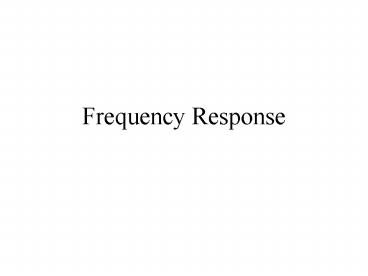Frequency Response
1 / 45
Title: Frequency Response
1
Frequency Response
- Instructor Chia-Ming Tsai
- Dept. of Electronics Engineering
- National Chiao Tung University
2
Contents
- Introduction
- Transfer Function
- The Decibel Scale
- Bode Plots
- Series Resonance
- Parallel Rosonance
- Passive Filters
- Active Filters
- Applications
3
Introduction
- Analysis with a constant frequency is already
learned. - To obtain the frequency response
- Keep the amplitude and the phase of the
sinusoidal source constant. (amplitude 1, phase
0) - Sweep the frequency from a starting frequency to
a stop frequency. - Plot the amplitude and the phase of the desired
voltage or current versus frequency.
4
Transfer Function
- The transfer function H(?)
- can be expressed as
- Zeros the roots of N(?)0
- Poles the roots of D(?)0
5
Example 1
Time domain
Phasor domain
6
Example 2
7
Example 3
8
The Thought of Bode Plots
- It is quite difficult to handle the plotting of
the transfer function in a linear scale. - If the transfer function is transformed to a
logarithmic scale, then the plotting becomes much
more easy.
9
The Decibel (dB) Scale
10
Bode Plots
11
Bode Plots
- Steps to construct a Bode plot
- Plot each factor separately.
- Additively combine all of them graphically
because of the logarithms involved. - The mathematical convenience of the logarithm
makes the Bode plots a powerful tool. - Straight-line plots used instead of actual plots.
12
Bode Plots A Gain K
13
Bode Plots Zero/Pole at Origin
14
Bode Plots Simple Zero
15
Bode Plots Simple Pole
16
Bode Plots Quadratic Pole
17
Bode Plots Quadratic Zero
18
Summary
19
Summary
20
Summary
21
Example 1
22
Example 1 (Contd)
23
Example 2
24
Example 2 (Contd)
25
Example 3
26
Example 3 (Contd)
27
Series Resonance
28
When Resonance Occurs
- The impedance is purely resistive. The LC series
combination acts like a short circuit. - The voltage and the current are in phase, so the
power factor is unity. - The impedance Z(?) is minimum.
- The voltage across L and C can be much larger
than the source voltage.
29
Half-Power Frequencies
30
Quality Factor Q
31
Summary
32
Parallel Resonance
33
When Resonance Occurs
- The impedance is purely resistive. The LC
parallel combination acts like an open circuit. - The voltage and the current are in phase, so the
power factor is unity. - The admittance Y(?) is minimum.
- The current flowing through L and C can be much
larger than the source current.
34
Comparisons
Parallel circuit
Series circuit
35
Passive Filters
Lowpass
Bandpass
Highpass
Bandstop
36
Lowpass Filter
37
Highpass Filter
38
Bandpass Filter
39
Bandstop Filter
rejection frequency
40
Active Filters
A general 1st-order active filter
Active 1st-order lowpass filter
41
Active 1st-Order Highpass Filter
42
Active Bandpass Filter
(gain)
43
Active Bandpass Filter
44
Bandreject (or Notch) Filter
45
Bandreject (or Notch) Filter































